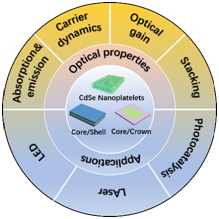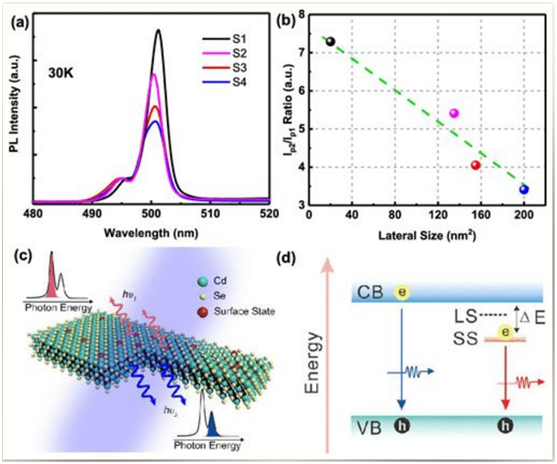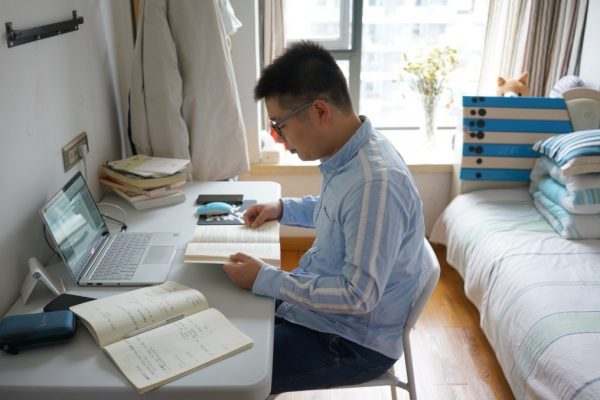I have so many people to thank. Medical staff from all over the country flocked to Wuhan and Hubei Province, risking their lives. People from every province, municipality, and autonomous region supported us in our darkest hour. The entire SUSTech community reached out to ensure that my family and I were coping. Thank you to every single one of you.
Doctoral candidate Jiahao Yu
On April 7, SUSTech-Harbin Institute of Technology (HIT) joint doctoral candidate Jiahao Yu published his latest paper in the academic journal InfoMat, a new publication. His paper was titled “Optical properties and applications of two‐dimensional CdSe nanoplatelets.” His research focus is on the optical properties and applications of semiconductor nanomaterials.

Figure 1. Important optical properties and various applications of two-dimensional CdSe nanoplatelets
As nanomaterial synthesis technology advances, cadmium-selenium (CdSe) nanoplatelets with a two-dimensional structure have been successfully synthesized. They make excellent semiconductor nanomaterials as they are just a few molecular layers thick. Their current applications include light-emitting diodes (LEDs), photocatalysis, light collection, and other optoelectronic fields.
His paper reviewed the progress of research and development in the synthesis and preparation of these nanoplatelets in recent years. It also assessed the many unique optical properties of CdSe nanoplatelets.
The paper was an advancement of his previous work, published in the high-impact academic journal ACS Applied Materials and Interfaces, under the title, “Effect of Lateral Size and Surface Passivation on the Near-Band-Edge Excitonic Emission from Quasi-Two-Dimensional CdSe Nanoplatelets.”

Figure 2. (a) The photoluminescence (PL) spectrum of CdSe nanoplatelets with different lateral dimensions at 30K (normalized by the intensity of the high-energy peak), (b) the ratio of low-energy peak PL intensity (Ip2) to high-energy peak PL intensity (Ip1) plotted against the lateral dimensions of CdSe nanoplatelets, (c) Schematic diagrams of different luminescence sources of CdSe nanoplatelets at low temperatures, (d) Schematic diagrams of energy levels of CdSe nanoplatelets.
The ACS Applied Materials & Interfaces paper sought to explain the mechanism by which CdSe nanoplatelets materials luminesce at ultra-low temperatures. Jiahao Yu explained the source of a second luminescence peak, following his experiments.
His low-temperature spectroscopy experiments used four different CdSe nanoplatelets, which proved the relationship between the low-energy peaks and the surface of the nanomaterial. It also provided further validation for the hypothesis that luminescence at the low-energy end is derived from the nanoplatelets’ surface state.
Jiahao Yu pointed out that his paper proved that the surface of the CdSe nanoplatelets is critical to their optical properties. It provides further development opportunities and applications for the use of nanomaterials in optoelectronic devices.

Personal Profile
Jiahao Yu is from Wuhan and returned home to spend time with his family in the lead-up to the Chinese New Year holiday. While he missed out on many of the traditional activities and the general feeling was not in the air, his primary desire was for the outbreak of the novel coronavirus (COVID-19) to end as soon as possible. Jiahao Yu and his family relied on materials they had acquired over the years to ensure that they would not need to leave the house for many days. He believed that all levels of government had worked tirelessly to effectively control the epidemic.
While Jiahao Yu remained at home, he had to take some time to adjust to the new situation. It was not an optimal environment, academically or emotionally, to work and study in his field. Ultimately, it was the receipt of the peer review of his paper that snapped him out of his funk and got him back in the groove for his academic pursuits. Jiahao YU started talking to his mentors and tutors, before moving on to revising his paper. After several rounds of revision, the paper in InfoMat was finally accepted.
Reflecting on that period, Jiahao YU felt that the time he has spent learning and studying eliminated much of the negative influence of the epidemic that surrounded him. The fighting spirit of fellow Wuhaners inspired him, and he continued to improve himself to add to his foundation for future research. He has read many papers on related research directions, which has helped him develop a broader idea for designing experiments that relate to his current focus.
Jiahao YU will soon return to campus while carrying forward the fighting spirit of Wuhan. He will incorporate that spirit into his laboratory and his academic pursuits as he progresses onto further SCI articles.
InfoMat paper – https://onlinelibrary.wiley.com/doi/full/10.1002/inf2.12106
ACS Applied Materials & Interfaces – https://pubs.acs.org/doi/10.1021/acsami.9b16044
Proofread ByYingying XIA
Photo ByDepartment of Electrical and Electronics Engineering, Yan QIU